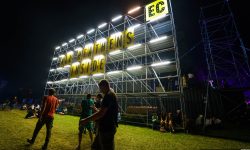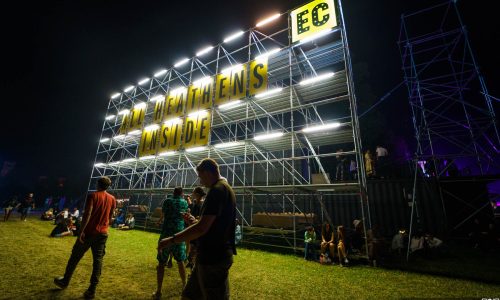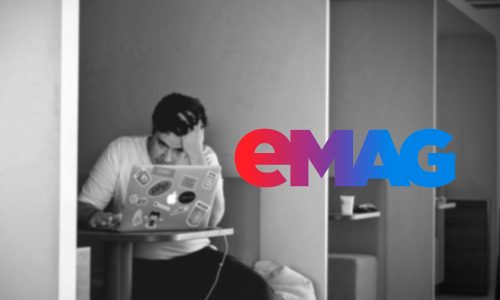The exhibition “Archives of Short-Lived Materialities” is an artistic event taking place as part of the Opera Aperta Festival 2024. This exhibition is organised by Polyhedron, a cultural organisation dedicated to promoting emerging artists.

The event showcases the works of five artists living and working in Cluj-Napoca: Silviu Ciora, Tudor Costin, Ema Măhălean, Eduard Szilagyi, and Simona Tudose. The installations from “Archives of Short-Lived Materialities” are set up on Iuliu Maniu Street.
The displayed works explore the boundary between human interaction with the natural world and the signs of our presence within it. The event raises questions about our perception of and relationship with a distant past, as well as humanity's ability to adapt to climate change and coexist with the ever-changing elements of nature.
Silviu Ciora – Out of Balance
Currently pursuing his doctoral research in art installations at the University of Art and Design in Cluj-Napoca, Silviu Ciora has collaborated with several festivals and events over the past six years, producing over ten light installations both nationally and internationally. Fascinated by light and the niche of art festivals, he combines artistic practices with technology and entrepreneurship. As an artist, his aim is to bring colour and light into urban spaces. His installation, “Out of Balance,” invites the audience to reflect on how our decisions impact the environment. The mosquito serves as a metaphor for the individual in society, creating noise wherever they go.
Tudor Costin – Future Archeologies
Tudor Costin, a visual artist based in Cluj-Napoca, explores themes of reality perception through his artistic practice, particularly what he terms “the fine line between the fiction and the Real of memory,” the relationship between the present, past, and future, and aspects of urban life. By visually adapting the concept of the Carnivalesque, theorised by Mikhail Bakhtin, through humour and chaos, he seeks a subversive stance toward dominant social discourses by adopting a relaxed approach.
His proposed installation, “Future Archeologies,” brings to the forefront a module that interprets the display of remnants from extinct civilisations or fossils dating millions of years, typically seen in history and natural history museums. “Future Archeologies” contemplates how our present might be exhibited in the future, either as an artefact of humanity that has overcome the climate crisis or as remnants of a different species unfamiliar to us.
Ema Măhălean – Komorebi
Ema Măhălean, a master's student at the University of Art and Design in Cluj-Napoca, within the Textile Design department, introduces the term “Komorebi” from the Japanese language and culture, which describes the warm rays of sunlight filtering through tree leaves. Often used to express the subtle beauty of nature, “Komorebi” is the narrative thread from which the artist's discourse begins. Her work is a personal exploration of how the concept of Komorebi can be translated into textile art. Using shibori and tie-dye techniques, Ema Măhălean captures the essence of Komorebi through distinct textures and patterns, with the resulting imperfections reflecting the unpredictability of nature.
Eduard Szilagyi – Ruins of the Future
Eduard Szilagyi, active in the field of graphic design and interested in documentary photography, video art, music, poetry, and short prose, presents a work inspired by cinematography. His installation, “Ruins of the Future,” is designed as a reproach to the illusion of eternity, composed as a segment of time often met with speculation of the concrete. “Ruins of the Future” stands at the boundary between the beautification of the unrealised and the dishonour of a collective turmoil, presented as an archaeological site defining an imaginary epoch.
Simona Tudose – Step by Step in Luminescence
Simona Tudose, a visual artist living and working in Cluj-Napoca, constructs her artistic discourse around the injustices faced by contemporary women, focusing on romantic experiences, and female perception and self-perception. Primarily working with painting as her main form of expression, she also explores experimental areas such as site-specific installations, sound art, and new media art.
Her installation, “Step by Step in Luminescence,” begins with the uncertainty of truly knowing the external world, where human experience is a representation of a singular self. Through the present materials, the artist proposes a limited space and time for the audience to literally step through. “Step by Step in Luminescence” aims to bring the imprints of the present into a composition of a collective self for a brief period. The installation invites the audience to engage with it—walking through, lying down, touching the installation, and returning at night to see their own mark left in a space and time that is disappearing.
The “Archives of Short-Lived Materialities” marks the second consecutive year of collaboration between Polyhedron and the Romanian National Opera in Cluj-Napoca. It is part of the International Opera Aperta Festival in Cluj-Napoca, running from June 25 to June 30, 2024.



